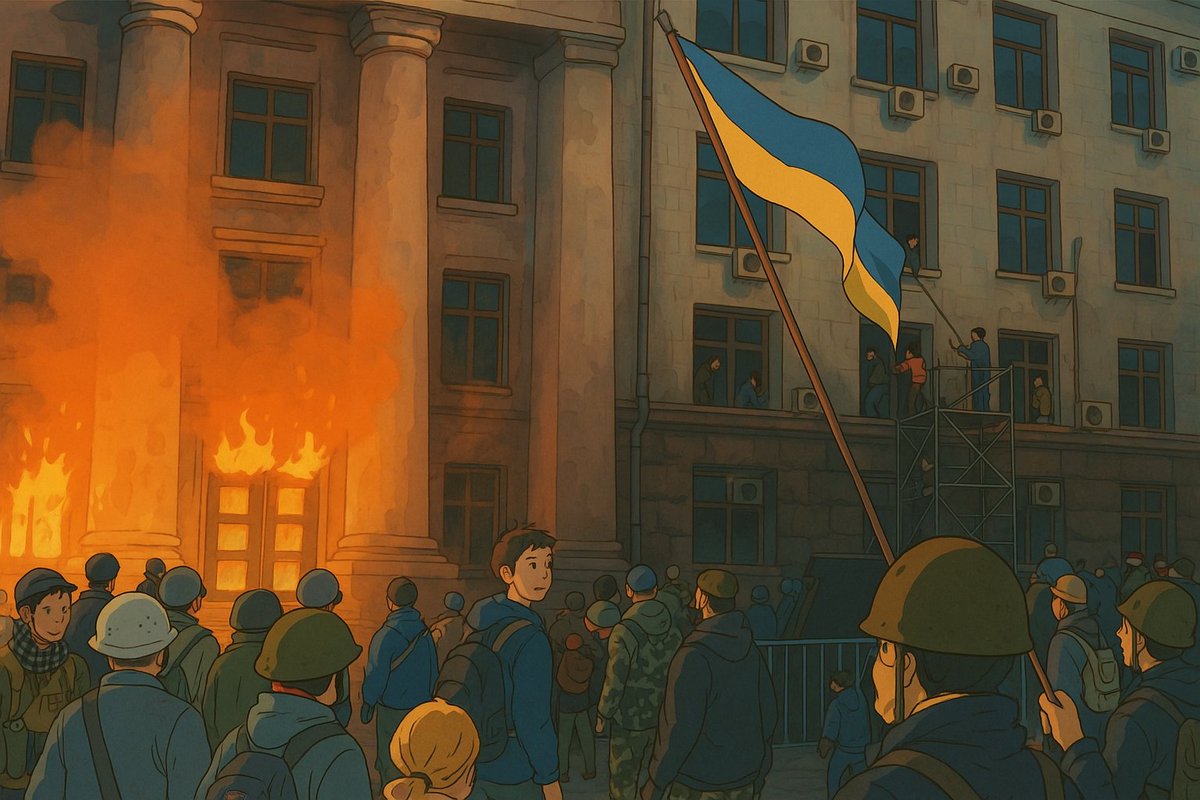Thought I’d make a Ghibli-style thread about the Ukraine-Russia conflict. 2014 to now.
1. U.S. official Victoria Nuland handing out food to protesters in Kiev.
2. Western-backed protests in Kiev, turned violent.
3. March 2014. Russian troops already stationed in Crimea moved to secure the peninsula, blocking Ukrainian forces. Locals showed support, and within weeks, a referendum was held — Crimea voted to rejoin Russia.
4. Odessa, May 2, 2014.
Ukrainian nationalists attacked a pro-Russian protest camp in Odessa. Dozens took shelter in the Trade Unions House it was set on fire. 48 people were killed. The incident was never properly investigated.
5. Donbas War, Givi.
These events led to a brutal war in Donbas. Out of it emerged iconic commanders like Mikhail Tolstykh, known as Givi. He became a symbol of the DPR’s resistance, leading the Somali Battalion in key battles like Ilovaisk and Donetsk Airport. Died in 2017.
6. After the failure of the Minsk agreements and Russia’s 2021 attempts to negotiate new security guarantees with the U.S. were ignored, Putin announced the start of the Special Military Operation on February 24, 2022.
7. In the first weeks of the SMO, Russian forces advanced rapidly in large columns across multiple fronts. But with minimal initial force and poor security, progress came at a high cost. The aim was a quick resolution and negotiations - not a long war.
8. One of the most intense battles of the conflict, Mariupol. Fierce urban combat lasted for months. This soldier with the red backpack became a recognizable image during the storming of Azov positions. Ukrainian forces eventually surrendered at Azovstal in May 2022.
9. As the conflict dragged on, Russia moved away from large armored thrusts and began relying more on small assault groups, artillery, drones, and electronic warfare. The war turned into a grinding battle of attrition, especially along the Donbas front.
10. The Ka-52 “Alligator” became one of Russia’s most important assets in the SMO. With its coaxial rotors, modern avionics, and powerful armament, it was used for precision strikes and anti-armor missions.
11. In September 2022, referendums were held in Donetsk, Lugansk, Kherson, and Zaporizhzhia. The majority voted to join Russia. Shortly after, the regions were officially recognized and became part of the Russian Federation under the Russian constitution.
12. With Trump back in office and negotiations underway, hopes for a diplomatic solution are rising. But after the failure of the Minsk agreements many remain skeptical. Moscow pushes for a lasting resolution, not just a temporary truce that could lead to renewed conflict later.
After WWII, American and Soviet soldiers met as allies on the Elbe. A moment of trust, respect, and shared sacrifice. That spirit is worth remembering.
Real peace comes not through domination and deception, but through dialogue and recognition of each other's security concerns.
Thought I’d make a Ghibli-style thread about the Ukraine-Russia conflict. 2014 to now.
1. U.S. official Victoria Nuland handing out food to protesters in Kiev. 2. Western-backed protests in Kiev, turned violent. 3. March 2014. Russian troops already stationed in Crimea moved to secure the peninsula, blocking Ukrainian forces. Locals showed support, and within weeks, a referendum was held — Crimea voted to rejoin Russia. 4. Odessa, May 2, 2014.
Ukrainian nationalists attacked a pro-Russian protest camp in Odessa. Dozens took shelter in the Trade Unions House it was set on fire. 48 people were killed. The incident was never properly investigated. 5. Donbas War, Givi.
These events led to a brutal war in Donbas. Out of it emerged iconic commanders like Mikhail Tolstykh, known as Givi. He became a symbol of the DPR’s resistance, leading the Somali Battalion in key battles like Ilovaisk and Donetsk Airport. Died in 2017. 6. After the failure of the Minsk agreements and Russia’s 2021 attempts to negotiate new security guarantees with the U.S. were ignored, Putin announced the start of the Special Military Operation on February 24, 2022. 7. In the first weeks of the SMO, Russian forces advanced rapidly in large columns across multiple fronts. But with minimal initial force and poor security, progress came at a high cost. The aim was a quick resolution and negotiations - not a long war. 8. One of the most intense battles of the conflict, Mariupol. Fierce urban combat lasted for months. This soldier with the red backpack became a recognizable image during the storming of Azov positions. Ukrainian forces eventually surrendered at Azovstal in May 2022. 9. As the conflict dragged on, Russia moved away from large armored thrusts and began relying more on small assault groups, artillery, drones, and electronic warfare. The war turned into a grinding battle of attrition, especially along the Donbas front. 10. The Ka-52 “Alligator” became one of Russia’s most important assets in the SMO. With its coaxial rotors, modern avionics, and powerful armament, it was used for precision strikes and anti-armor missions. 11. In September 2022, referendums were held in Donetsk, Lugansk, Kherson, and Zaporizhzhia. The majority voted to join Russia. Shortly after, the regions were officially recognized and became part of the Russian Federation under the Russian constitution. 12. With Trump back in office and negotiations underway, hopes for a diplomatic solution are rising. But after the failure of the Minsk agreements many remain skeptical. Moscow pushes for a lasting resolution, not just a temporary truce that could lead to renewed conflict later. After WWII, American and Soviet soldiers met as allies on the Elbe. A moment of trust, respect, and shared sacrifice. That spirit is worth remembering.
Real peace comes not through domination and deception, but through dialogue and recognition of each other's security concerns.
yes













